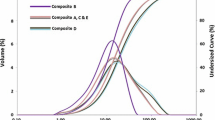The macroscopic mechanical properties of a particulate composite under uniaxial tensile loading have been estimated. The composite studied consisted of a polymer matrix in a rubbery state (polymethylmethacrylate – PMMA) and alumina-based particles (Al2O3). A numerical modeling by using the finite-element method (FEM) was performed to determine the stress–strain behavior of the particulate composite. The numerical simulation took into account the hyperelastic properties of the cross-linked polymer matrix, which was described by the three-parameter Mooney–Rivlin material model. A representative volume element (RVE) was chosen for FE analyses to model the microstructure of the composite. Various compositions of particles and their different shape and orientation were considered in the study. Various directions of loading of the RVE were also investigated. A progressive damage model was implemented into the numerical models. The mechanical characteristics obtained from computations, which included the damage model, were compared with experimental data, and a good agreement has been found to exist between them. The procedure presented can be used for estimating the mechanical properties of new particulate composites with a cross-linked polymer matrix, and it also contributes to the clarification of damage development and failure in composites of the type studied.








Similar content being viewed by others
References
T. lung and M. Grange, “Mechanical behaviour of two-phase materials investigated by the finite element method: necessity of three-dimensional modeling,” Mater. Sci. Engng., A201, L8-L11 (1995).
H. P. Gänser, F. D. Fischer, and E. A. Werner, “Large strain behavior of two-phase materials with random inclusions,” Camp. Mater. Sci, 11, 221-226 (1998).
N. Chawla, R. S. Sidhu, and V. V. Ganesh, “Three-dimensional visualization and microstructure-based modeling of deformation in particle-reinforced composites,” Acta Mater., 54, 1541-1548 (2006).
P. R. Marur, “Estimation of effective elastic properties and interface stress concentrations in particulate composites by unit cell methods,” Acta Mater., 52, 1263-1270 (2004).
W. Han, A. Eckschlanger, and H. J. Böhru, “The effects of three-dimensional multi-particle arrangements on the mechanical behavior and damage initiation of particle-reinforced MMCs,” Compos. Sci. Technol., 61, 1581-1590 (2001).
X. Wang, K. Xiao, L. Ye, Y. W. Mai, C. H. Wang, and L. R. F. Rose, “Modelling of mechanical properties of core-shell rubber modified epoxies,” Acta Mater., 48, 579-586 (2000).
X. Zeng, H. Fan, and J. Zhang, “Modelling of mechanical properties of core-shell rubber modified epoxies,” Camp. Mater. Sci, 40, 395-399 (2007).
J. Cho, M. S. Joshi, and C. T. Sun, “Effect of inclusion size on mechanical properties of polymeric composites with micro and nano particles,” Compos. Sci. Technol., 66, 1941-1952 (2006).
P. Hutař, Z. Majer, L. Náhlík, L. Šestáková, and Z. Knésl, Mech. “The influence of particle size on the fracture toughness of a PP-based particle composite," Mechanics of Compos. Mater., 45, No. 3, 281-286 (2009).
P. Hutař, L. Náhlík, Z. Majer, Z. Knésl, “The Effect of an Interphase on Micro-Crack Behaviour in Polymer Composites, Computational Modelling and Advanced Simulations," Computational Methods in Applied Sciences, I, Vol. 24, Computational Modelling and Advanced Simulations, Springer, 83-97, 2011
L. Náhlík, P. Hutař, M. Dušková, K. Dušek, and B. Máša, “Numerical estimation of the macroscopic stress-strain curve of a particulate composite with crosslinked polymer matrix,” Mechanics of Composite Materials, 47, 627-634 2012.
J. Segurado, C. Gonzáles, and J. LLorca, “Anuruerical investigation of the effect of particle clustering on the mechanical properties of composites,” Acta Mater., 51, 2355-2369 (2003).
D. Arencón and J. I. Velasco, “Fracture toughness of polypropylene-based particulate composites,” Materials, 2, 2046-2094 (2009).
L. R. G. Treloar, The Physics of Rubber Elasticity, third edition Oxford University Press, Oxford, UK, 2005.
Ansys Release 12.1 Docuruentation (ANSYS, Inc. USA 2009).
Acknowledgment
This work was supported through the Specific academic research grant of the Ministry of Education, Youth and Sports of the Czech Republic No. FSI-J-12-21/1693 provided to Brno University of Technology, Faculty of Mechanical Engineering and grant No. 106/09/H035 of Czech Science Foundation. The research was realized in CEITEC – Central European Institute of Technology, with a research infrastructure supported by the project CZ.1.05/1.1.00/02.0068 financed from the European Regional Development Fund.
Author information
Authors and Affiliations
Corresponding author
Additional information
Russian translation published in Mekhanika Kompozitnykh Materialov, Vol. 49, No. 4, pp. 627-638 , July-August, 2013.
Rights and permissions
About this article
Cite this article
Máša, B., Náhlík, L. & Hutař, P. Particulate Composite Materials: Numerical Modeling of a Cross-Linked Polymer Reinforced With Alumina-Based Particles. Mech Compos Mater 49, 421–428 (2013). https://doi.org/10.1007/s11029-013-9358-y
Received:
Revised:
Published:
Issue Date:
DOI: https://doi.org/10.1007/s11029-013-9358-y




